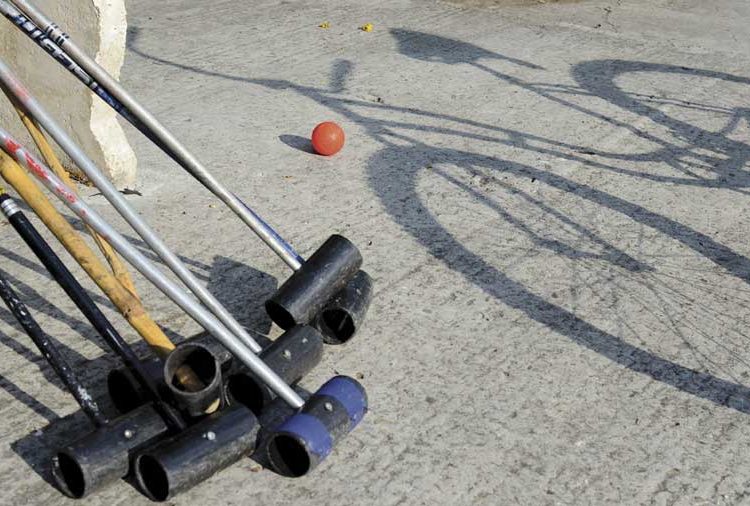And with a blast of the whistle, Cuba’s hottest new sport gets underway in Havana’s Vedado neighborhood. Whacking a little ball while pedaling at top speed, the goal approaching fast, a defender’s mallet poised to knock your shot sounds like a special kind of Cuban madness. Yet bike polo, an adaptation of the same sport played on horseback, was invented in 1891 by a feisty Irishman.
Within a decade the craze had caught on and was being played in England, France, and the United States. Leagues were formed and championships won, lost, and recouped – it even debuted as an exhibition sport in the 1908 London Olympics. But economic crises and wars intervened, sending bike polo into a decades-long dormancy from which it didn’t emerge in earnest until the 1990s.
Today bike polo is a global phenomenon, with 403 clubs in 47 countries competing regularly. New clubs are cropping up all over and on January 29, 2012, The Havana Bike Polo Club took the court for the first time. Brought to Cuba by some intrepid Canadians, bike polo was an instant hit, with Cubans digging into the new sport like an all-you-can-eat buffet. “Bike polo suits Cuba,” says Club co-founder Christina Mills. “It’s challenging and Cubans like challenges. They’re also such good athletes and excel at whatever sport – especially team sports like bike polo.”
The rules are similar to soccer, with teams of three facing off in untimed matches; the first to five wins. But as with most passionate pursuits, the devil is in the details: touching the ground is a foul, requiring the player to “tap out” before pedaling back onto the court and only goals made with the head of the mallet count. This gets complicated (and crowded) with six bicycles rolling around the court; falls and crashes are frequent. “There’s a steep learning curve – it takes agility, balance, and no small measure of strategy. But once you get the hang of it, bike polo is incredibly fun,” says Havana Club president Otto Álvarez.
Fun is putting it mildly. At the weekly Havana matches, jibes and jokes fly about the court as fast as the 1950s Schwinns ridden by several club members. “I’m not afraid to attack and crash with this bike,” Club vice president Henry Cabrera boasts, pointing to his pink 1952 Schwinn. “But my 1955 exhibition bike? No way I’m bringing that baby out here!”
Cabrera explains that the technique required to play on these antique bikes – with their back pedal brakes – isn’t easy since you lose all momentum once you stop, something Rodney Ramos also contends with. The only BMX rider in the Club, Ramos explains that his smaller ride provides “more maneuverability and stability, but it’s hell getting going again once I stop.” Putting a foot down to kick start his momentum elicits a blow from the ref’s whistle accompanied by shouts of ‘to the wall!’ and provides a 3-on-2 opportunity for the opposing team.
One of the hallmarks of bike polo is the sport’s democratic underpinnings. Mills explains that “it started in the street, among bike messengers and reflects that urban, DIY subculture. It’s also super age-inclusive. Our club members range from 12 to 63, proving you can play bike polo at any age.” Age inclusive it is, but what about gender? Less than 10% of membership in the Havana Club is female, something president Álvarez laments: “unfortunately, this is a macho society, still. But we’re trying to achieve more gender balance with targeted publicity, plus our logo is the only one in the world, to our knowledge, that features a woman.”
Club member Vladimir Pozo is all for it and has introduced his 12-year old daughter Laura – who, like her dad, competes on a 1950s Schwinn – to the sport. “I was fascinated by bike polo the first time I played,” says Pozo. “The enthusiasm for the sport here is incredible and we hope people from other countries and clubs come to play in Havana.”
Considering how closely bike riding is associated with hard times in Cuba, it’s encouraging how fast the sport has caught on. “We spent so many years riding bikes and while there’s prejudice held over from the Special Period, 90% of us ride well…once someone sees how entertaining the sport is, they’re hooked,” says Álvarez. Leonardo Roque is proof: “I didn’t know anything about this sport, but it’s fun and easy to learn,” he says after scoring his first goal ever.
Mills predicts bike polo will grow in popularity, which bodes well for cycling culture in Cuba. Indeed, just a few months ago, several Sundays passed without enough bikes to field two teams, but today, bikes and players come from as far as Habana del Este and Boyeros to play. The Club is a gregarious, handy bunch, with members sharing parts and know-how between matches; several are professional bike mechanics who get to work after crashes and falls.
To see what all the fuss (and fun) is about, stop by the matches held every Sunday at 4pm on the court at Calles 23 and 2. If you don’t have wheels of your own, no worries – Club members lend their bikes willingly. But keep in mind, one of the official rules of bike polo is: losers buy the beers!









